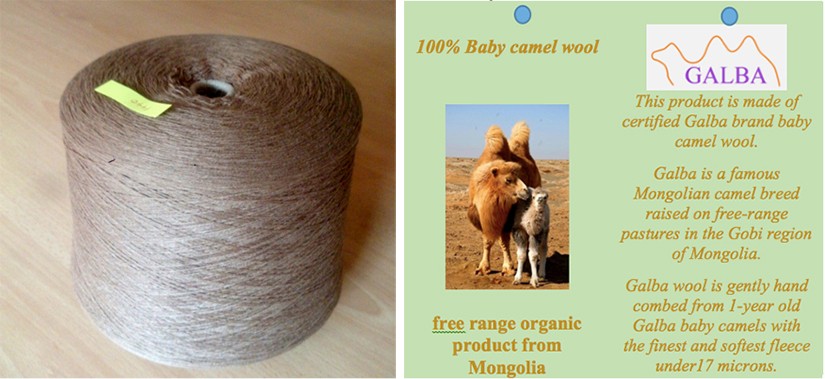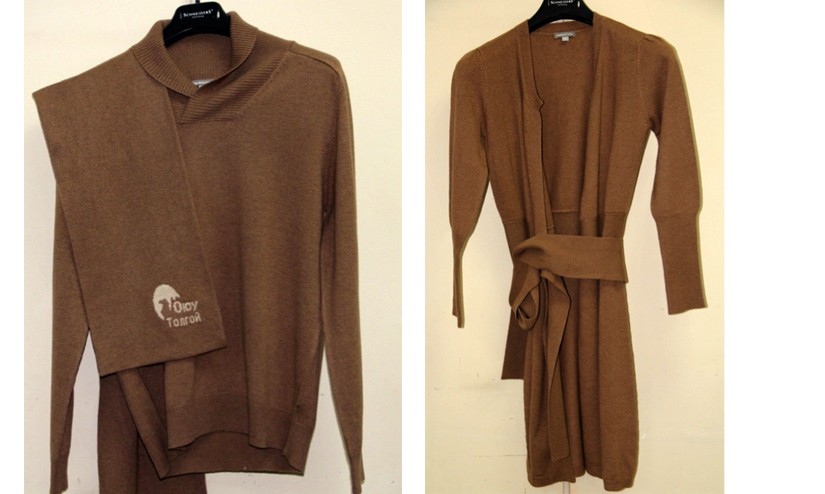The annual autumn market organized by the Khanbogd soum government on 25-26 this month at the soum’s Galba square will attract local businesses from the Khanbogd, Bayan-Ovoo, Manlai and Dalanzadgad soums.
During the planned event the Center Policy Research (CPR), professional contractor for the Oyu Tolgoi’s ‘Local Business and Economic Development’ program shall present outcomes of its local business support activities targeted at improving local peoples’ livelihoods by improving competitiveness and market linkages of the traditional livestock herding as a major source of income and jobs in the Gobi region.
Developing a camel brand product was one of the CPR interventions. Baby camel wool was chosen as the most promising brand products from among 12 wool, meat and milk candidates by using the criteria – the maximum number of beneficiaries (everybody with camels can benefit), compatibility with the Gobi region comparative advantages, and use of feasible but innovative technologies.
The pilot, started from the 2015 wool preparation season has promoted the collaboration between herders, procurement cooperatives/changers and all levels of processors, has proved that hand combed baby camel wool is much more beneficial for every participant in the value chain due to higher yield, quality, prices fetched. Herders from 12 khot ails partcipated in the pilot by combing 354 baby camels to collect 510.7 kg. of wool.
Baby camel combed wool comparison against traditional sheared wool
|
Indicators |
Combed |
Sheared |
|
Yield per camel, kg |
1.44 |
2.5 |
|
Byproduct per camel, kg |
1 |
- |
|
Herders income per kg, MNT |
10400 |
4000 |
|
Total income per camel, MNT |
18976 |
10000 |
|
Average micron |
16 |
21 |
|
Dehairing yield, % |
98 |
94 |
|
Scouring yield, % |
72 |
65 |
|
Combing yield, % |
60 |
33 |
|
Spinning yield, % |
91 |
83 |
Currently, pilot manufacturing of end products using baby camel wool is underway.
Fine yarn #26.2 spun using Galba wool Galba baby camel wool brand label

Sample end products manufactured using Galba baby camel wool:


Under the 2015 pilot herders have earned additional income of MNT 6400 selling combed wool for MNT 10400 per kg while the market price for camel wool (traditionally baby camel wool was not separated but sold together with adult camel wool) was MNT 4000. The pilot has shown that benefits accrue to not only herders, but also processors can increase their incomes up to 45%. This shows that no one wins in the current practices to compete with each other by offering minimum prices, instead everyone - herders, cooperatives and processors -can benefit if they can collaborate with longer-term visions to enhance the national industry competitiveness and to reach better markets by improving the product quality.
Combed baby camel wool is valued much higher than adult camel wool at the international markets. For example, World Textile Information Network (WTiN)’s ‘Wool Market Report’ indicates that baby camel wool with 18 microns is priced at USD 38 per kg (around MNT 76000) as of 16 July 2015. Eurostex company from the Bradford, UK asks USD 90 per kg of 17 micron baby camel wool from the Alashan, Inner Mongolia’s region neighboring with the Umnugobi and Bayankongor aimags.
To realize the pilot benefits and to reach high end markets such as mentioned above, the pilot model needs to be scaled up by replicating it into regular partnership agreements across wool value chain participants in the 2016 wool season; local wool quality monitoring /certification has to be established in the soum (worth around USD 20000 investments), and relevant support programs and funding need to be reflected in the local development policies, budgets and project financing.
In addition, the model needs to be linked to the government wool support policies by making it more rationalized to stimulate the quality rather than quantity and camel breeding needs to be much advanced to be focused on wool quality improvements. The pilot model is believed to demonstarte one way how the Gob region livestock herding can run at the equal pace with the expanding mining industry.
Center for Policy Research
The annual autumn market organized by the Khanbogd soum government on 25-26 this month at the soum’s Galba square will attract local businesses from the Khanbogd, Bayan-Ovoo, Manlai and Dalanzadgad soums.
During the planned event the Center Policy Research (CPR), professional contractor for the Oyu Tolgoi’s ‘Local Business and Economic Development’ program shall present outcomes of its local business support activities targeted at improving local peoples’ livelihoods by improving competitiveness and market linkages of the traditional livestock herding as a major source of income and jobs in the Gobi region.
Developing a camel brand product was one of the CPR interventions. Baby camel wool was chosen as the most promising brand products from among 12 wool, meat and milk candidates by using the criteria – the maximum number of beneficiaries (everybody with camels can benefit), compatibility with the Gobi region comparative advantages, and use of feasible but innovative technologies.
The pilot, started from the 2015 wool preparation season has promoted the collaboration between herders, procurement cooperatives/changers and all levels of processors, has proved that hand combed baby camel wool is much more beneficial for every participant in the value chain due to higher yield, quality, prices fetched. Herders from 12 khot ails partcipated in the pilot by combing 354 baby camels to collect 510.7 kg. of wool.
Baby camel combed wool comparison against traditional sheared wool
|
Indicators |
Combed |
Sheared |
|
Yield per camel, kg |
1.44 |
2.5 |
|
Byproduct per camel, kg |
1 |
- |
|
Herders income per kg, MNT |
10400 |
4000 |
|
Total income per camel, MNT |
18976 |
10000 |
|
Average micron |
16 |
21 |
|
Dehairing yield, % |
98 |
94 |
|
Scouring yield, % |
72 |
65 |
|
Combing yield, % |
60 |
33 |
|
Spinning yield, % |
91 |
83 |
Currently, pilot manufacturing of end products using baby camel wool is underway.
Fine yarn #26.2 spun using Galba wool Galba baby camel wool brand label

Sample end products manufactured using Galba baby camel wool:


Under the 2015 pilot herders have earned additional income of MNT 6400 selling combed wool for MNT 10400 per kg while the market price for camel wool (traditionally baby camel wool was not separated but sold together with adult camel wool) was MNT 4000. The pilot has shown that benefits accrue to not only herders, but also processors can increase their incomes up to 45%. This shows that no one wins in the current practices to compete with each other by offering minimum prices, instead everyone - herders, cooperatives and processors -can benefit if they can collaborate with longer-term visions to enhance the national industry competitiveness and to reach better markets by improving the product quality.
Combed baby camel wool is valued much higher than adult camel wool at the international markets. For example, World Textile Information Network (WTiN)’s ‘Wool Market Report’ indicates that baby camel wool with 18 microns is priced at USD 38 per kg (around MNT 76000) as of 16 July 2015. Eurostex company from the Bradford, UK asks USD 90 per kg of 17 micron baby camel wool from the Alashan, Inner Mongolia’s region neighboring with the Umnugobi and Bayankongor aimags.
To realize the pilot benefits and to reach high end markets such as mentioned above, the pilot model needs to be scaled up by replicating it into regular partnership agreements across wool value chain participants in the 2016 wool season; local wool quality monitoring /certification has to be established in the soum (worth around USD 20000 investments), and relevant support programs and funding need to be reflected in the local development policies, budgets and project financing.
In addition, the model needs to be linked to the government wool support policies by making it more rationalized to stimulate the quality rather than quantity and camel breeding needs to be much advanced to be focused on wool quality improvements. The pilot model is believed to demonstarte one way how the Gob region livestock herding can run at the equal pace with the expanding mining industry.
Center for Policy Research

